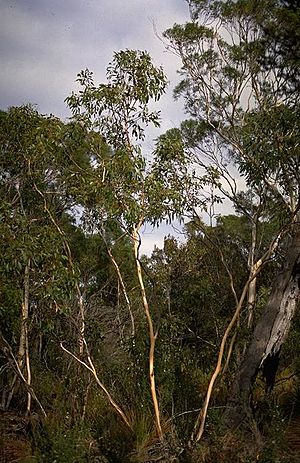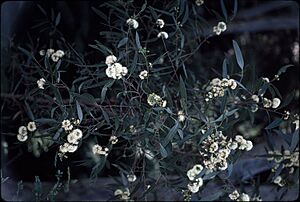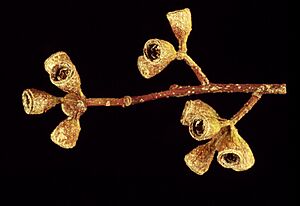Barber's gum facts for kids
Quick facts for kids Barber's gum |
|
|---|---|
 |
|
| Scientific classification | |
| Genus: |
Eucalyptus
|
| Species: |
barberi
|
Eucalyptus barberi, also known as Barber's gum, is a special type of tree or mallee. A mallee is a type of eucalyptus that grows with many stems from the ground, like a bush. This plant is endemic to Tasmania, which means it grows naturally only in Tasmania and nowhere else in the world.
Barber's gum usually has smooth, greyish bark. Its adult leaves can be oval, shaped like a spear, or slightly curved. The flower buds look like diamonds or clubs and grow in groups of seven where the leaves meet the stem. When it blooms, it has white flowers. After flowering, it produces fruit that looks like a cup, cylinder, or cone.
Contents
What Does Barber's Gum Look Like?
Barber's gum can grow as a mallee, which is a shrubby form, usually between 1 to 5 meters (about 3 to 16 feet) tall. It can also grow as a tree, reaching up to 8 meters (about 26 feet) high. This plant has a special woody swelling at its base called a lignotuber. This helps it regrow after fires or damage.
Bark and Leaves
The bark of Barber's gum is mostly smooth. It can be greyish, brownish, or yellowish. Sometimes, you might see loose strips of rough bark near the bottom of the tree. The smooth bark often has ribbons of bark peeling off its upper branches.
Young plants and new shoots that grow after damage (called coppice regrowth) have leaves arranged in opposite pairs. These leaves are spear-shaped to oval or oblong. They are about 30 to 80 millimeters (1 to 3 inches) long and 10 to 30 millimeters (0.4 to 1.2 inches) wide. Each young leaf has a small stalk called a petiole.
Adult leaves are shiny green on both sides. They can be oval, spear-shaped, or curved. These leaves are typically 50 to 140 millimeters (2 to 5.5 inches) long and 10 to 35 millimeters (0.4 to 1.4 inches) wide. They also have a petiole, which is about 10 to 35 millimeters (0.4 to 1.4 inches) long.
Flowers and Fruit
The flower buds of Barber's gum grow in groups of seven. They are found where the leaves join the stem, in areas called axils. These groups of buds grow on a stalk called a peduncle, which is about 5 to 18 millimeters (0.2 to 0.7 inches) long. Each individual bud has its own tiny stalk, called a pedicel, about 2 to 4 millimeters (0.08 to 0.16 inches) long.
When the buds are ready, they are oval, diamond-shaped, or club-shaped. They measure about 7 to 11 millimeters (0.28 to 0.43 inches) long and 4 to 6 millimeters (0.16 to 0.24 inches) wide. Each bud has a cap, called an operculum, which is conical or rounded. This cap is about 3 to 5 millimeters (0.12 to 0.20 inches) long and often has a beak-like tip.
Barber's gum flowers are white and bloom between August and December. After the flowers, the plant produces a woody fruit. This fruit is a type of capsule and can be cup-shaped, cylindrical, or conical. It is typically 5 to 10 millimeters (0.2 to 0.4 inches) long and 6 to 9 millimeters (0.24 to 0.35 inches) wide. Each fruit sits on a pedicel about 1 to 5 millimeters (0.04 to 0.20 inches) long.
How Barber's Gum Got Its Name
The scientific name for Barber's gum, Eucalyptus barberi, was first officially described in 1972. This was done by two scientists, Lawrie Johnson and Donald Blaxell. They studied a plant sample collected near a place called Cranbrook.
The second part of the scientific name, barberi, is called the specific epithet. It was chosen to honor a person named Horace Barber.
Where Does Barber's Gum Grow?
Barber's gum grows in dry forests in eastern Tasmania. You can often find it on the edges of rocky areas made of a type of rock called dolerite. It also grows on low hills and sloping ground.
This special tree is protected in the Douglas Apsley National Park, helping to keep it safe for future generations.



